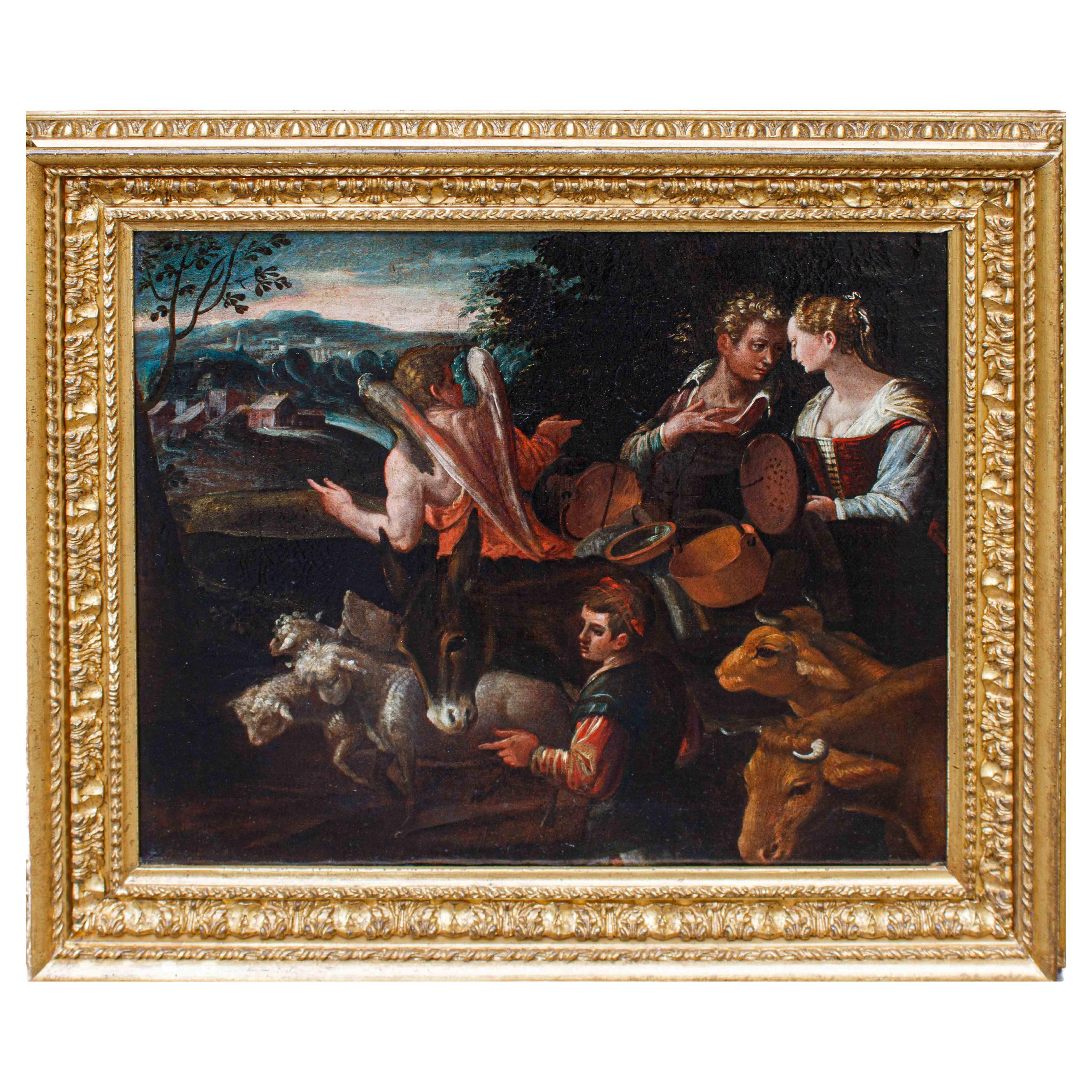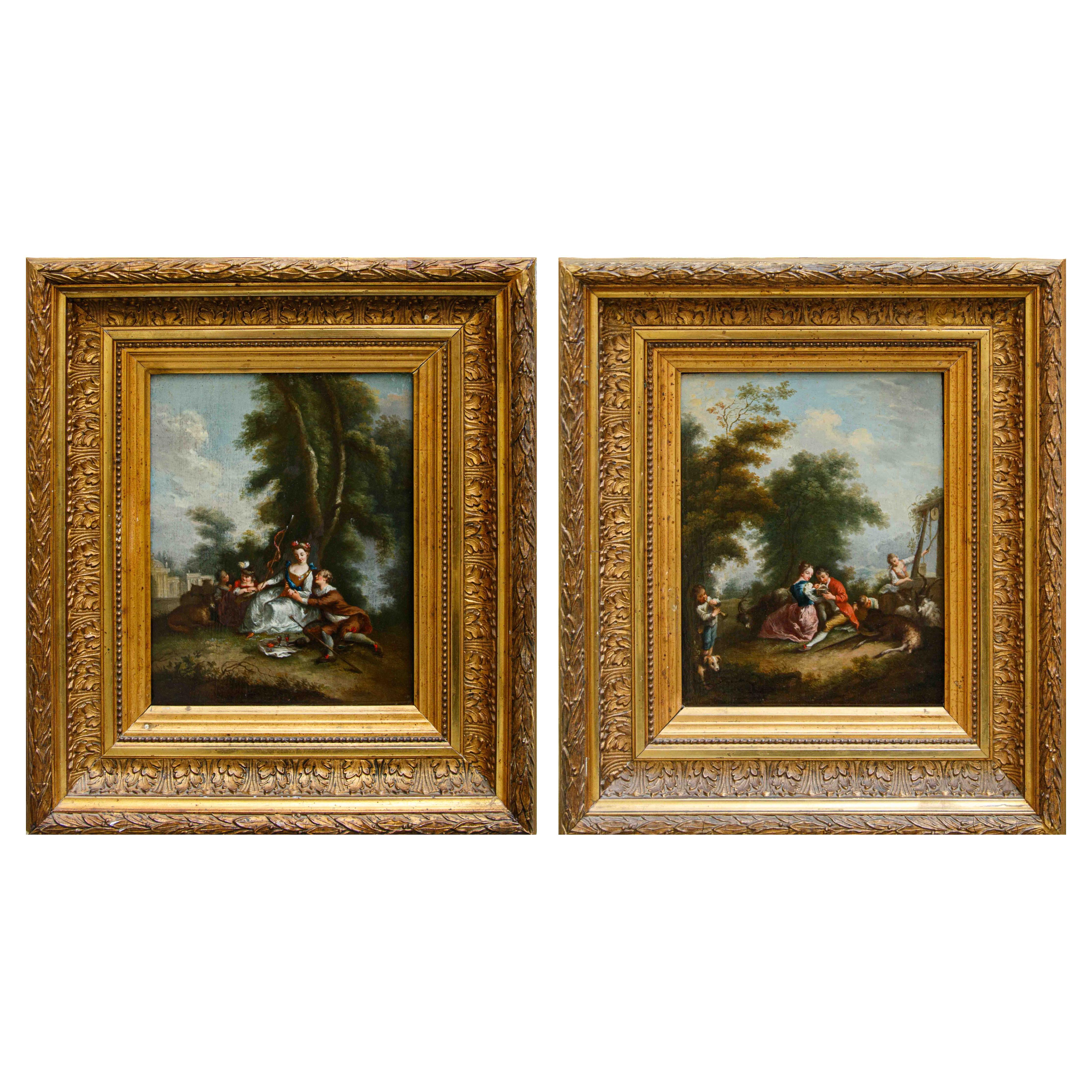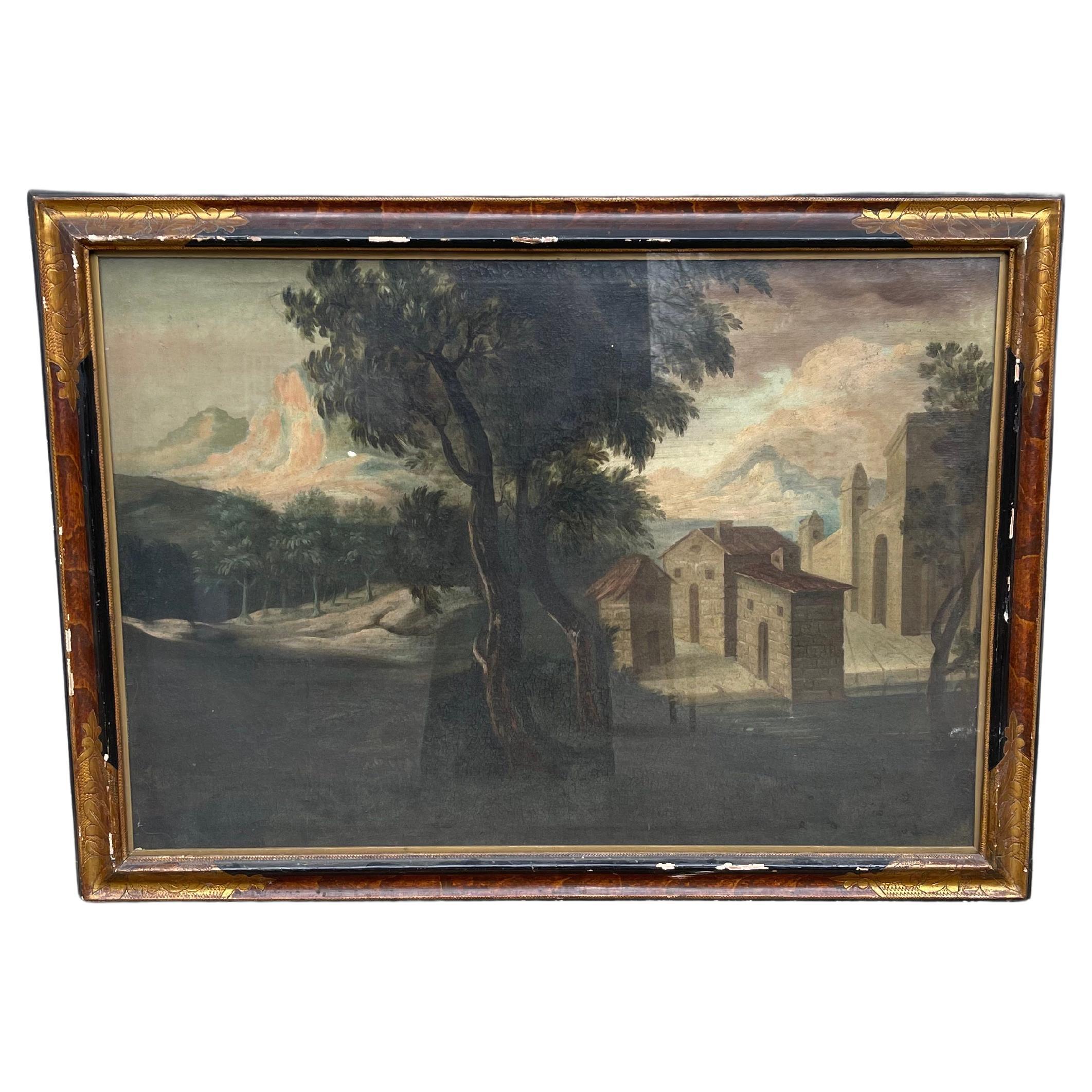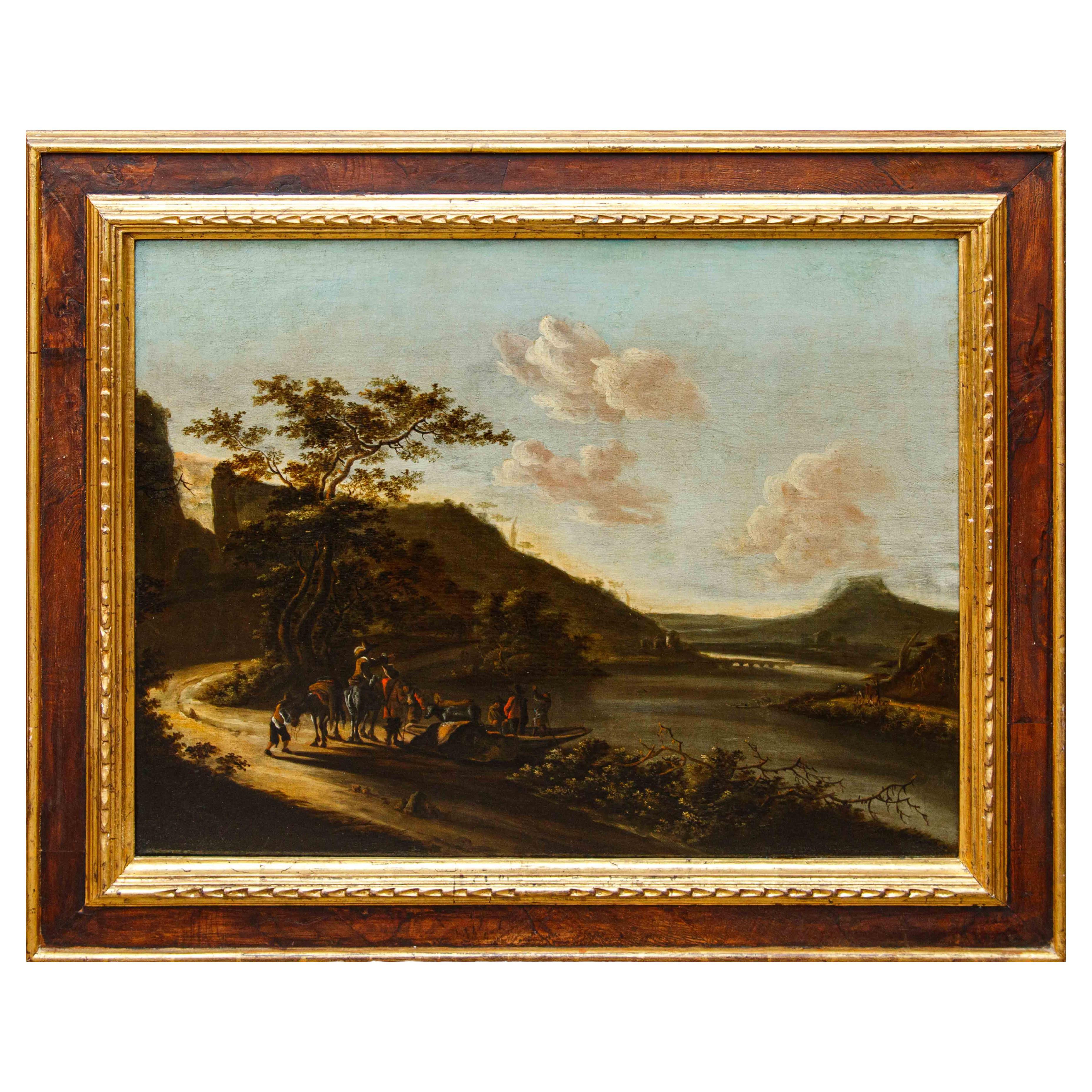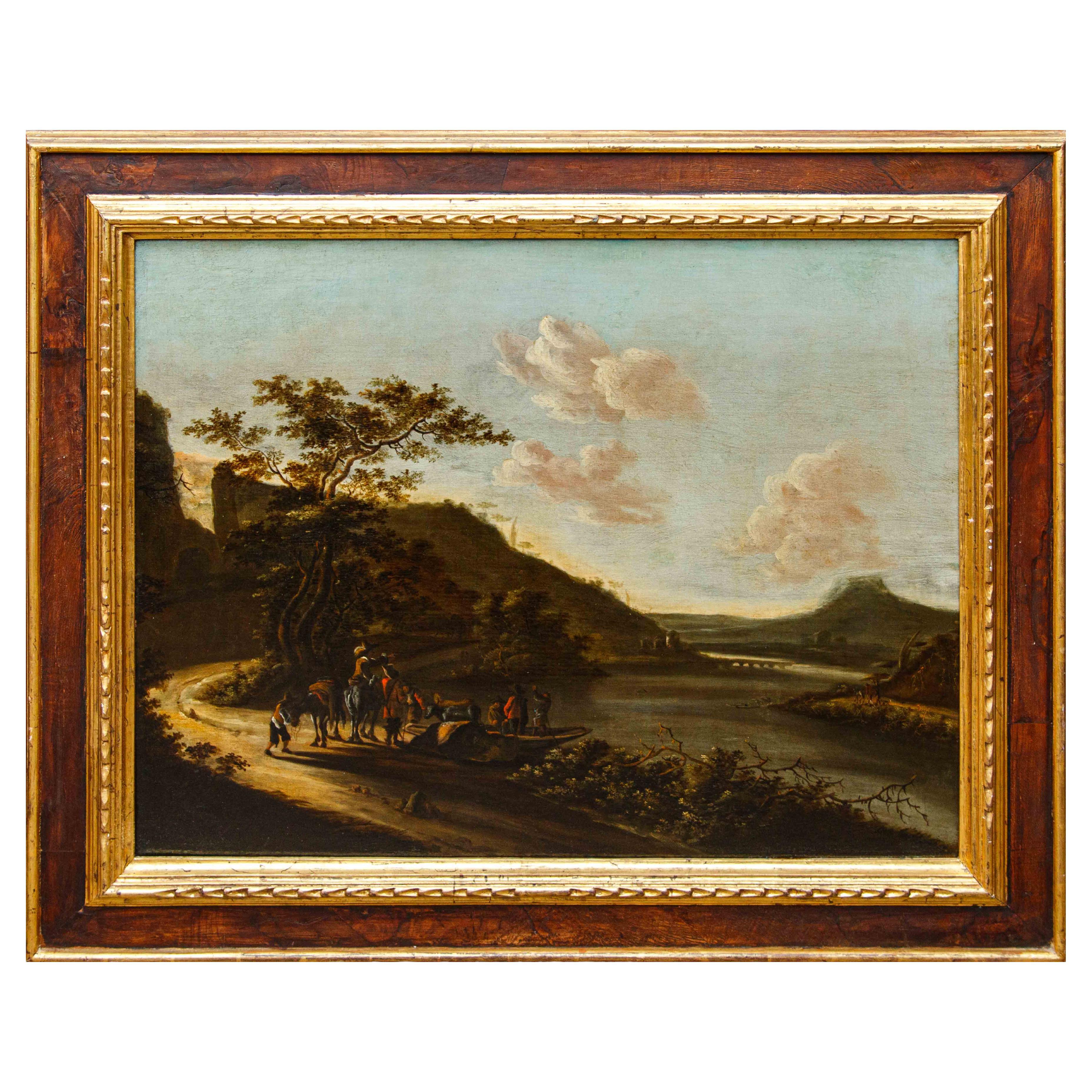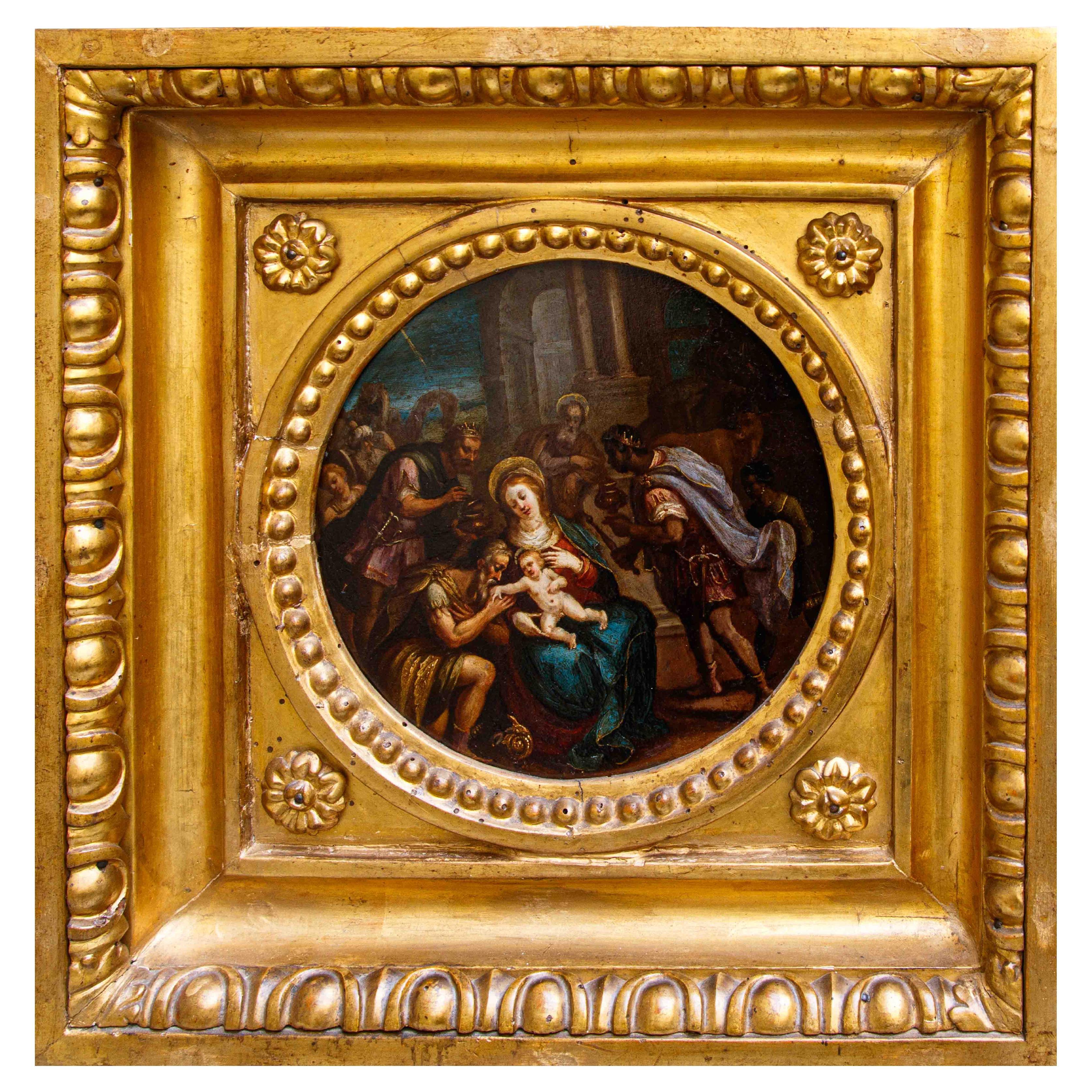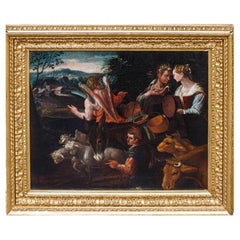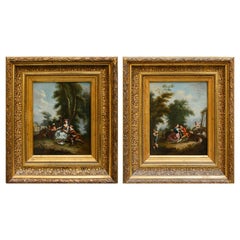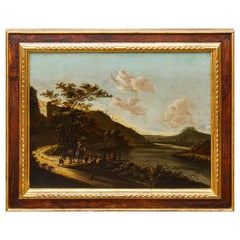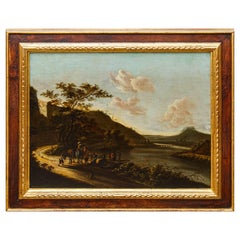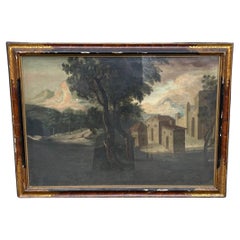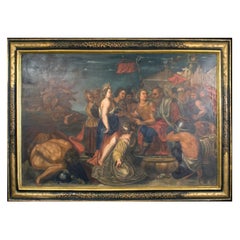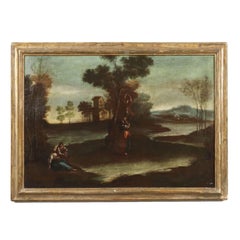Items Similar to 17th century, Emilian school, Rural landscape with gallant scenes
Want more images or videos?
Request additional images or videos from the seller
1 of 15
17th century, Emilian school, Rural landscape with gallant scenes
$3,507.23
£2,645.09
€3,010
CA$4,849.05
A$5,431.75
CHF 2,852.95
MX$66,048.34
NOK 36,127.68
SEK 34,294.89
DKK 22,914.09
About the Item
17th century, Emilian school
Rural landscape with gallant scenes
Oil on canvas, 37 x 47.5 cm
Framed, 61 x 50.5 cm
The bucolic amenity of the present is reflected within the joyous gallant scenes that dot its surface. The locus amoenus described reasons on the more traditional inflection of Arcadia, which in literary transfiguration was the scene par excellence of the most carefree and out-of-the-world pastoral life; the painting is thus anticipatory of what was professed by the actual poetic Academy of Arcadia that was established in Rome in 1690, but it bears enthusiastic witness to its feverish invitations for its reception, then widespread in the most avant-garde cultural salons throughout Italy. Theocritus first and Virgil later had awakened with Idylls and Eclogues that capacity typical of the natural world to allow an escape from reality; the contemplation of the perfect natural fruits that followed would evoke in the spirits of men dreamy returns to origins. The bucolic landscape was able to positively cadence material life, and was the concretization of a place free of incivility and imbruity, where only dreams, sylvan music and homage to fruitful nature were allowed.
In the present painting, widespread figures of shepherd children trace the same intent to the sublimation of earthly life, reunited in pairs, while children modeled after ancient cherub-lovers brighten the field with flowers and petals. The games of these and the sweet affections of the other characters are rendered through liquid, vibrant brushstrokes, darting with a white light that opposes the dark shadows of the undergrowth. In the distance, the sky is tapered through a flat, silvery brushstroke, while the vertical development of promoters with architecture helps to introject a bright beam of light within the grassy clearing. The foliage and turf of the landscape piece are rendered through a digital brushstroke, betraying the Italian brand of the present, simultaneously influenced by the seventeenth-century European influences then channeling into the capital. The evocative culture of the Urbe attracted multiple artists from the city of Bologna, from northern Italy but also from territories beyond the Alpine belt, such as Claude Lorrain and Nicolas Poussin. The art-historical legacy of Italian pastoral scenes was thus able to replenish itself with the more functional formalisms and particular veits from elsewhere, such as the expressive flickering of the present, similar to the coeval French lexicon.
The typological restitution from pastoral idyll, in accordance with the intrinsic stylistic qualities of the work, allows us to specify the solid belonging of the present to the Italian hand, similarly to what was then emerging in painting within the Emilian school. Recall in this regard the latent influences of two decisive foreign landscape painters who transited the Emilian belt, such as Claude Lorrain (1600-1682) and Nicolas Poussin (1594-1665); before them, Giovanni Battista Viola (1576-1622), also engaged on Roman soil, sowed a figurative handbook for later landscape painters; likewise, the celebrated Domenichino (Domenico Zampieri, said, 1581-1641) made sweeping panoramas, dotted with a frayed and stringy nature, with handfuls of figurines scattered to color its nooks and crannies, an exemplary constant of Emilian landscape painting, as is equally the case in the present.
- Dimensions:Height: 18.51 in (47 cm)Width: 14.57 in (37 cm)Depth: 1.97 in (5 cm)
- Style:Other (Of the Period)
- Materials and Techniques:Canvas,Oiled
- Place of Origin:
- Period:
- Date of Manufacture:XVII Century
- Condition:Wear consistent with age and use.
- Seller Location:Milan, IT
- Reference Number:1stDibs: LU5918245600062
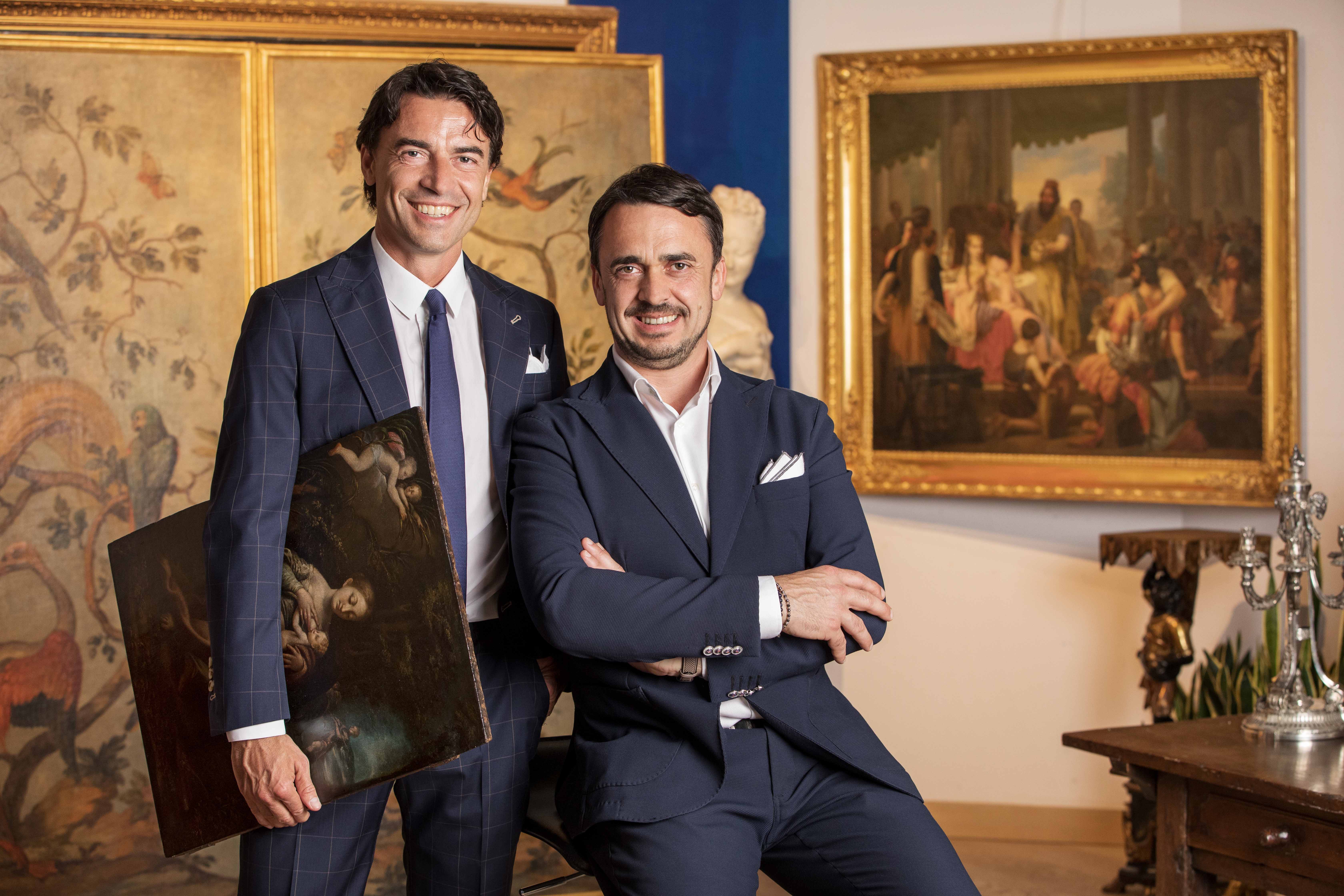
About the Seller
5.0
Vetted Professional Seller
Every seller passes strict standards for authenticity and reliability
Established in 2000
1stDibs seller since 2021
30 sales on 1stDibs
- ShippingRetrieving quote...Shipping from: Milan, Italy
- Return Policy
Authenticity Guarantee
In the unlikely event there’s an issue with an item’s authenticity, contact us within 1 year for a full refund. DetailsMoney-Back Guarantee
If your item is not as described, is damaged in transit, or does not arrive, contact us within 7 days for a full refund. Details24-Hour Cancellation
You have a 24-hour grace period in which to reconsider your purchase, with no questions asked.Vetted Professional Sellers
Our world-class sellers must adhere to strict standards for service and quality, maintaining the integrity of our listings.Price-Match Guarantee
If you find that a seller listed the same item for a lower price elsewhere, we’ll match it.Trusted Global Delivery
Our best-in-class carrier network provides specialized shipping options worldwide, including custom delivery.More From This Seller
View AllVenetian school, Tobias and Sara in Nineveh, oil on canvas, 16th century
Located in Milan, IT
Venetian School, second half of the 16th century
Tobiah and Sarah led to Nineveh by the archangel Azariah
Oil on canvas, 48 x 56 cm - Framed, 58 x 72 cm
The present canvas, made w...
Category
Antique 16th Century Paintings
Materials
Canvas
18th century, French School, Gallant scenes
Located in Milan, IT
18th century, French School
Gallant Scenes
(2) Oil on panel, 24 x 19 cm
Framed, 44 x 36 cm
This pair of works attributable to the artistic context of the French eighteenth centu...
Category
Antique 18th Century and Earlier Italian Other Paintings
Materials
Wood
17th century, Landscape with characters
Located in Milan, IT
XVII Century
Landscape with characters
Oil on canvas, 72 x 92 cm
Framed, 95 x 112 cm
Category
Antique Late 17th Century Dutch Other Paintings
Materials
Canvas
17th century, Landscape with characters
Located in Milan, IT
XVII Century
Landscape with characters
Oil on canvas, 72 x 92 cm
Framed, 95 x 112 cm
Category
Antique 18th Century and Earlier Dutch Other Paintings
Materials
Canvas
17th century, Flemish School, Adoration of the Magi
Located in Milan, IT
17th century, Flemish School
Adoration of the Magi
Oil on copper, diam. 19.5 cm
Framed 35.3 x 35.3 cm
Engraved on the back in seventeenth-century calligraphy "Fiamingo"
Vivid wo...
Category
Antique 18th Century and Earlier Dutch Other Paintings
Materials
Copper
Neapolitan school of the 17th-18th centuries, Bacchus and Ariadne abandoned by Theseus
Located in Milan, IT
Neapolitan school of the 17th-18th centuries
Bacchus and Ariadne abandoned by Theseus
Oil on canvas, 74 x 100 cm
Framed, 89 x 111 cm
The painting under consideration, attributab...
Category
Antique 18th Century and Earlier Italian Other Paintings
Materials
Canvas
You May Also Like
antico paesaggio - scuola romana - olio su tela - fine 18 secolo - dipinto
Located in Milano, MI
antico paesaggio - scuola romana - olio su tela - fine 18 secolo - dipinto
antico paesaggio - scuola romana - olio su tela - fine 18 secolo - dipinto
...
Category
Antique 1890s Italian Paintings
Materials
Canvas
Giuseppe Tassoni "Landscape with herds and family of shepherds"
Located in Milano, IT
Giuseppe Tassoni (1653 -1737)
"Landscape with herds and shepherd family."
oil on canvas, 154x206 cm, with frame 170x223 cm
Signed "G. Tassoni F. and 1726" at bottom center
20...
Category
Antique 18th Century Italian Paintings
Materials
Canvas
Large historical painting 18th century, Italian school
Located in Cesena, FC
Large historical painting 18th century, Italian school
"Darius' mother pleading before Alexander after the battle of Issus."
Oil on canvas 210 x 290 cm
Painted with great strength...
Category
Antique Late 18th Century Italian Paintings
Materials
Canvas, Wood, Giltwood
Painting Landscape with Figures, 18th century
Located in Milan, IT
Oil on Canvas. North Italian school of the 18th century.
The landscape, set on the bank of a wide river, features several figures of peasants in the center intent on picking fruit fr...
Category
18th Century Other Art Style Landscape Paintings
Materials
Oil
Italian School; Holy Family with St. Anne, 17th-18th century, oil on canvas
Located in Brescia, IT
Description
Holy Family with St. Anne
Oil on canvas
cm 75,5x57
In the center is clearly distinguished the Virgin Mary, seated with a halo, looking at the Child Jesus, who is held by...
Category
Antique Early 18th Century Italian Louis XIV Paintings
Materials
Canvas
17th Century, Italian Painting by Pier Francesco Cittadini, Jacob and his Family
Located in IT
Pier Francesco Cittadini (Milan, 1616-Bologna, 1681)
"Jacob and his family go to Egypt"
Oil on canvas, cm 109 x 190 (canvas only)
The valuable painting, made in oil on canvas, depicts Jacob and his family go to Egypt and we believe it can be, given the high quality painting, autograph work of Italian Pier Francesco Cittadini (Italy Milan, 1616 - Bologna, 1681) made after 1647. The work, in excellent condition is accompanied by a coeval frame in wood finely carved and golden.
The scene depicted, which was confused with the Flight to Egypt in the past years, is instead identified with the biblical episode of Jacob’s journey. In the foreground, reading the painting from left to right, we see a caravan composed of animals, including donkeys, dromedaries, goats, dogs and horses and people, women, men and slaves, who carry on their journey along the banks of a river, following a path that to the right, would seem to lead to the through of a bridge. In addition to the watercourse is described an environment characterized by large rocks and impervious come far to cover the entire verticality of the canvas. On the left, in the distance, we see the tail of the caravan that runs along the steep path. Large trees enliven and harmonize the environment, as well as white and grey clouds characterize the predominantly clear sky and illuminated on the right by sunlight.
The story is told in the Bible, Book of Genesis, 30, 25, passage in which is described the flight of Jacob from Haran after the contrasts with Laban, father of his wife Rachel. Jacob is the third great patriarch of the Bible. From his descendants originate the twelve generations of the people of Israel. He is the son of Isaac and Rebekah, who led him to flee from the wrath of Esau to Haran to seek refuge from his brother, Laban. At his uncle’s house Jacob met his daughter Rachel. As soon as he saw his cousin, Jacob was taken. Jacob will stay seven years in the service of Laban to marry his beloved Rachel. But Laban, with a deception, will give him in marriage first Lia, the least beautiful eldest daughter, and only after another seven years the splendid Rachel. From his first wife he will have several children, while Rachel will give birth to the beloved son, Joseph, who will become viceroy of Egypt.
After years of service, Jacob asked to be paid with every dark-coloured garment among the sheep and every spotted and dotted garment among the goats. Laban accepted and sent away from his sons all the leaders of that kind. So Jacob took fresh branches of poplar, almond and plane tree, and flayed them, and put them in the troughs. The optical suggestion induced the goats and the sheep to conceive and give birth to dark, striped and dotted garments. He also ensured that all the strongest and healthiest leaders of the flock of Laban would drink near the barked branches, thus assuring a genetic superiority to his part of the flock. His flocks grew numerous and strong and he became richer than his relative, arousing envy. It was clear that Laban would not respect him much longer. At the suggestion of the Lord, Jacob decided to return to Canaan. Trying to avoid any possible dispute, he left with his family while Laban was absent for shearing sheep. But when, three days later, his uncle returned home, he became angry, feeling offended because Jacob had gone secretly and had not allowed him to greet his daughters and grandchildren. In addition, his teraphim, statuettes, or idols, which depicted the family deities, had disappeared. After 7 days of pursuit, Laban and his men reached Jacob’s group on Mount Gilead, in the mountainous region west of the Euphrates River, where his uncle and grandson had a stormy conversation. The younger man was outraged at being accused of stealing idols and told Labano to rummage through his family’s tents at will. Neither of them could know or even imagine that it was Rachel who took the idols and hid them in the saddle of the camel. During the search, she sat down firmly on the saddle, apologizing for not being able to get up, «because I usually have what happens to women» (Gen 31:35). So the loot wasn’t discovered.
The author of this work was inspired by the composition of an engraving by Stefano Della Bella (1610-1664) of circa 1647. The engraving by Stefano della Bella bears the title "Iacob sur ses vieux jours quitte sans fascherie pour voir son filz Ioseph, sa terre et sa patrie" and is signed on the bottom left "Stef. of the Beautiful In. et fe." while on the right it is declared "Cum privil. Regis", that is with license of the king.
Stefano Della Bella (Italy - Florence, May 18, 1610-Florence, July 12, 1664) was born in a family of painters, sculptors and goldsmiths and was left early orphan of his father sculptor, he dedicated himself first to the art of goldsmith at the school of Giovanni Benedetto Castiglione and Gasparo Mola, then turning his attention to drawing and engraving. He soon began drawing figures and copying the etchings of Jacques Callot, which inspired his early works. Under the protection of the Medici, in particular of Don Lorenzo, cadet son of Grand Duke Ferdinand I, Della Bella has the opportunity to make study trips to Rome, where he stayed from 1633-1636; In Rome he met French engravers and publishers of prints such as Israël Henriet and François Langlois, who influenced his decision to move to Paris in 1639, four years after the death of Callot. In Paris he soon reached, thanks to the engravings commissioned by Cardinal Richelieu, the success also worldly; he frequented courtiers, theatre artists and writers, while refusing too oppressive honors. In 1646-1647 he continued his travels in the Netherlands to Amsterdam, Antwerp and Dordrecht. He returned to Florence in 1650 and resumed working under the protection of the Medici court, working for his patrons. In 1656 he became a member of the Academy of Apatists.
The painting object of this study is reasonably attributable to Pier Francesco Cittadini, or Pierfrancesco Cittadini, called the Milanese or the Franceschino (Italy - Milan, 1616-Bologna, 1681) as some exemplary stylistic comparisons proposed to follow can prove.
Pier Francesco Cittadini was an Italian baroque painter, mainly active in Bologna.
His artistic training first took place with the painter Daniele Crespi...
Category
Antique Mid-17th Century European Baroque Paintings
Materials
Canvas, Giltwood
